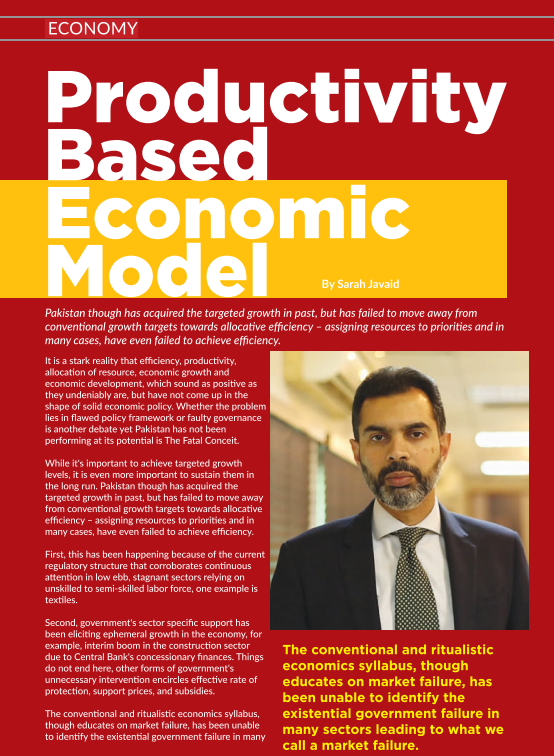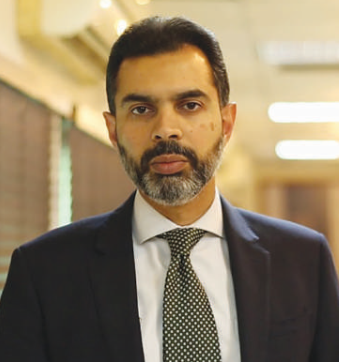
By Sarah Javaid
Pakistan though has acquired the targeted growth in past, but has failed to move away from conventional growth targets towards allocative efficiency – assigning resources to priorities and in many cases, have even failed to achieve efficiency.
It is a stark reality that efficiency, productivity, allocation of resource, economic growth and economic development, which sound as positive as they undeniably are, but have not come up in the shape of solid economic policy. Whether the problem lies in flawed policy framework or faulty governance is another debate yet Pakistan has not been performing at its potential is The Fatal Conceit.
While it’s important to achieve targeted growth levels, it is even more important to sustain them in the long run. Pakistan though has acquired the targeted growth in past, but has failed to move away from conventional growth targets towards allocative efficiency – assigning resources to priorities and in many cases, have even failed to achieve efficiency.
First, this has been happening because of the current regulatory structure that corroborates continuous attention in low ebb, stagnant sectors relying on unskilled to semi-skilled labor force, one example is textiles.
The conventional and ritualistic economics syllabus, though educates on market failure, has been unable to identify the existential government failure in many sectors leading to what we call a market failure.
Second, government’s sector specific support has been eliciting ephemeral growth in the economy, for example, interim boom in the construction sector due to Central Bank’s concessionary finances. Things do not end here, other forms of government’s unnecessary intervention encircles effective rate of protection, support prices, and subsidies.
The conventional and ritualistic economics syllabus, though educates on market failure, has been unable to identify the existential government failure in many sectors leading to what we call a market failure. There is a need to identify the competitive markets and release redundant barriers to productivity.
How well can this be achieved depends upon the capabilities of the policy makers in taking resources out from the less efficient towards more efficient businesses. This efficiency we often measure through the economic complexity and sophistication of an economy to produce i.e. making use of its productive capacity and being able to regionally and globally integrate. In order to have this done, there is a need for flexibility in terms of resources moving away from one activity to another – ‘the transformation’ leading to reallocation of resources.
The Economic Advisory Group (EAG), an independent panel of professionals from academia, policy and private sector, has been able to suggest the right recipe in form of four key policy areas in their recent document ‘New Vision for Economic Transformation: Rethinking Resource Allocation and Productive Structures’ which if adopted can ensure the economic transformation through resource re-allocation – employment, investment and capital.
The first remedy it proposes is the openness to integration with regional and international trade. As per World Bank, Pakistan remains the seventh most protected economy and the current tariff structure has been acting as a disincentive for the economy to integrate with global value chains. tax revenue generation from international trade in Pakistan is around 46%. Also, World Bank’s recent report – World Development Update has highlighted a similar issue of resource allocation, less productive exporting firms with little integration in Pakistan are stuck in a low equilibrium where these firms’ response to currency depreciation (increase in exports) is smaller than the other way round, as they struggle to generate capacity in the short run.
Resources that should have been diverted towards promoting insurance for small farmers and allowing private sector to import or store commodities, through targeting development of storage infrastructure, are instead being used in distorting production.
Some of the figures might simplify the context. Pakistan’s intra-regional trade is less than 5% in comparison with the global average i.e. 40%. For the past two decades, Pakistan’s export basked has remained unchanged – concentrating in unsophisticated goods like agriculture and textile where, export to GDP ratio is not even 10% as compared to Bangladesh (12%) and Vietnam (106%). Since 2003, Pakistan has been able to add just 21 goods to its export basket contributing $2 per capita to value of its exports and has gradually moved down the Economic Complexity Index from 102 in 1995 to 95 in 2018. Pakistan’s transformation towards complex products has not even begun.
Other solution is revisiting of pricing regime. Price – either acts as an incentive if generated through market forces, or a disincentive to production if regulated by government. The document offers sufficient evidence on the accumulated circular debt of Rs.163 billion (2010-2017) in form of wheat procurement. Fixing of prices in agriculture sector has led to a stagnant growth in yields.
Depletion of reserves leading to shortage and low prices of natural gas have induced little or no investment in gas exploration. Resources that should have been diverted towards promoting insurance for small farmers and allowing private sector to import or store commodities, through targeting development of storage infrastructure, are instead being used in distorting production.
Human capital in Pakistan is an outcome of existing education framework. For the past 20 years, economy has been spending Rs.50 – Rs.60 billion on higher education every year. In contrast, an accumulated amount of only Rs.25 billion was spent on vocational training in these two decades. Students tend to continue higher education in order to fit in the fancy system, often referred to as government jobs without realizing that the skill set, quite often, does not complement the job market.
The economy has spent resources in the wrong category of education. EAG’s document puts a direct emphasis on resource re-allocation in technical and vocational training of students starting from their school age till higher education, which would enable the private sector to bring in investment.
For the past two decades, Pakistan’s export basked has remained unchanged – concentrating in unsophisticated goods like agriculture and textile where, export to GDP ratio is not even 10% as compared to Bangladesh (12%) and Vietnam (106%).
EAG is of the view that role of the government is vital, most importantly when it comes to industrial strategy. However, the sectoral dominant policy often captured by lobby groups has diverted resources away from areas producing complex products. The document suggests on a move away from prevailing policy that includes selection of winners or losers towards providing support throughout the sectors through encouraging entrepreneurship,
Research and Development, simplification of sales tax, a collaboration with city governments and judiciary and availability of private sector credit are the need of the hour. The use of fiscal policy to reward or disincentivize selective sectors, which has also been crowding out small players, should be eroded through re-alignment of resources.
Following the launch of EAG’s document among private and government professionals, the Federal Minister Asad Umar appreciated the road map towards economic transformation and agreed to the fact that such discussions have never made to public domain. The need of the hour is the policy makers to realize the underlying causes of the missing transformation and ensure the allocation of resources not actually driven by vested interests rather, more focused in areas that need it the most. After all, economies become what they produce.

The writer is an Islamabad-based research economist at PRIME Institute, an independent think tank.




